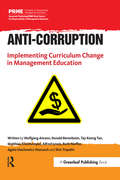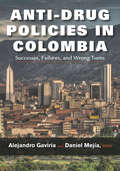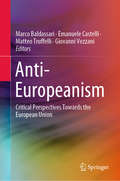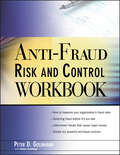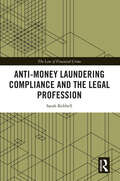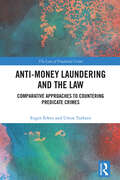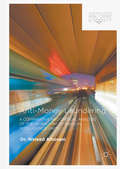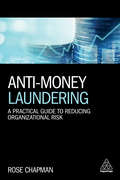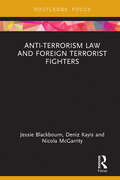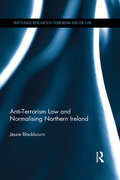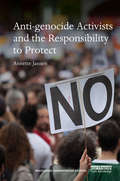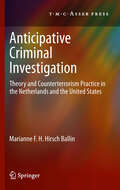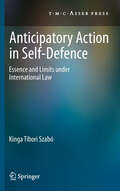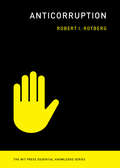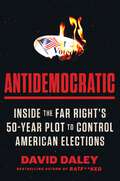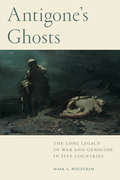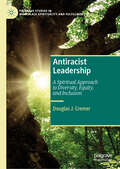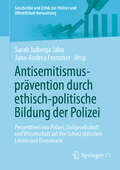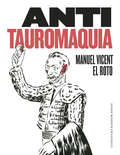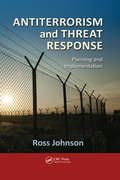- Table View
- List View
Anti-Corruption: Implementing Curriculum Change in Management Education (The Principles for Responsible Management Education Series)
by Wolfgang Amann Agata Stachowicz-Stanusch Tay Keong Tan Ronald Berenbeim Matthias Kleinhempel Alfred Lewis Ruth Nieffer Shiv TripathiSuccessful businesses are built on trust. Employees and colleagues need to trust one another and they need to deserve and receive trust from customers and suppliers. Anti-Corruption provides resources for building trust through the implementation of comprehensive guidelines on how to professionalize ethics and anti-corruption education worldwide in a variety of classroom settings. It is written and tested by highly experienced program directors, deans and professors, in how to adopt, adapt and develop best teaching practice. It highlights successful patterns, details illustrative case studies and offers clear, hands-on recommendations. Anti-Corruption enables business schools, management-related academic institutions, and Executive Training Programs to embed curriculum change quickly to achieve positive outcomes. It enables degree programs and executive education programs to achieve global standards that will be widely followed.
Anti-Drug Policies in Colombia: Successes, Failures, and Wrong Turns (Vanderbilt Center for Latin American Studies Series)
by Alejandro Gaviria Daniel Mejia Jimmy WeiskopfForty years after the declaration of the "war on drugs" by President Nixon, the debate on the effectiveness and costs of the ban is red-hot. Several former Latin American presidents and leading intellectuals from around the world have drawn attention to the ineffectiveness and adverse consequences of prohibitionism. This book thoroughly analyzes the drug policies of one of the main protagonists in this war.The book covers many topics: the economics of drug production, the policies to reduce consumption and decrease supply during the Plan Colombia, the effects of the drug problem on Colombia's international relations, the prevention of money laundering, the connection between drug trafficking and paramilitary politics, and strategies against organized crime. Beyond the diversity in topics, there is a common thread running through all the chapters: the need to analyze objectively what works and what does not, based on empirical evidence. Presented here for the first time to an English-speaking audience, this book is a contribution to a debate that urgently needs to transcend ideology and preconceived opinions.
Anti-Drug Policies in Colombia: Successes, Failures, and Wrong Turns (Vanderbilt Center for Latin American Studies Series)
by Alejandro Gaviria, Daniel Mejía; translated by Jimmy WeiskopfForty years after the declaration of the "war on drugs" by President Nixon, the debate on the effectiveness and costs of the ban is red-hot. Several former Latin American presidents and leading intellectuals from around the world have drawn attention to the ineffectiveness and adverse consequences of prohibitionism. This book thoroughly analyzes the drug policies of one of the main protagonists in this war. The book covers many topics: the economics of drug production, the policies to reduce consumption and decrease supply during the Plan Colombia, the effects of the drug problem on Colombia's international relations, the prevention of money laundering, the connection between drug trafficking and paramilitary politics, and strategies against organized crime. Beyond the diversity in topics, there is a common thread running through all the chapters: the need to analyze objectively what works and what does not, based on empirical evidence. Presented here for the first time to an English-speaking audience, this book is a contribution to a debate that urgently needs to transcend ideology and preconceived opinions.
Anti-Europeanism: Critical Perspectives Towards the European Union
by Marco Baldassari Emanuele Castelli Matteo Truffelli Giovanni VezzaniThe book analyzes different critical attitudes towards European integration from a multidisciplinary perspective. By applying both quantitative and normative-theoretical approaches, the contributors assess the causes and effects of the popularity of EU-critical positions and doctrines, such as souverainism, neo-nationalism and neo-populism. The book also presents country studies to compare populist movements and parties, such as the Five Stars Movement in Italy, Syriza in Greece and UKIP in the UK. It offers insights into the historical and normative roots of the diverse anti-European standpoints, and the various political demands and agendas connected with these views, ranging from rejections of EU institutions to demands for institutional reforms and propositions for alternative projects.
Anti-Fraud Risk and Control Workbook
by Peter Goldmann Hilton KaufmanProven guidance for fraud detection and prevention in a practical workbook formatAn excellent primer for developing and implementing an anti-fraud program, Anti-Fraud Risk and Control Workbook engages readers in an absorbing self-paced learning experience to develop familiarity with the practical aspects of fraud detection and prevention.Whether you are an internal or external auditor, accountant, senior financial executive, accounts payable professional, credit manager, or financial services manager, this invaluable resource provides you with timely discussion on:Why no organization is immune to fraudThe human element of fraudInternal fraud at employee and management levelsConducting a successful fraud risk assessmentBasic fraud detection tools and techniquesAdvanced fraud detection tools and techniquesWritten by a recognized expert in the field of fraud detection and prevention, this effective workbook is filled with interactive exercises, case studies, and chapter quizzes and shares industry-tested methods for detecting, preventing, and reporting fraud.Discover how to become more effective in protecting your organization against financial fraud with the essential techniques and tools in Anti-Fraud Risk and Control Workbook.
Anti-Impunity and the Human Rights Agenda
by Davis Karen Engle D. M. Zinaida MillerIn the twenty-first century, fighting impunity has become both the rallying cry and a metric of progress for human rights. The new emphasis on criminal prosecution represents a fundamental change in the positions and priorities of students and practitioners of human rights and transitional justice: it has become near-unquestionable common sense that criminal punishment is a legal, political, and pragmatic imperative for addressing human rights violations. This book challenges that common sense. It does so through careful research and critical analysis that trends toward an anti-impunity norm in a variety of institutional and geographical contexts, with an eye toward the interaction among practices at the global and local levels. Altogether the authors demonstrate how this laser focus on anti-impunity has created blind spots in practice and in scholarship that result in a constricted response to human rights violations, a narrowed conception of justice, and an impoverished approach to peace.
Anti-Money Laundering Compliance and the Legal Profession (The Law of Financial Crime)
by Sarah KebbellMoney laundering is a global issue and there is evidence that the services provided by the legal profession may be misused to launder the proceeds of crime. This book explores the experiences of professionals within Top 50 law firms when seeking to comply with the UK’s anti-money laundering (AML) regime. The book draws upon empirical evidence from 40 in-depth interviews with solicitors and compliance personnel from 20 Top 50 law firms. Access to this section of the legal profession is challenging in the context of academic research, and the research provides an account, seldom heard in academic literature, directly from practitioners. The book uses these research findings to explore and discuss the AML compliance issues faced by this section of the profession. It highlights the challenges presented by the legislative architecture of the Proceeds of Crime Act 2002, and considers compliance issues relating to customer due diligence, AML training, the client account and the suspicious activity reporting regime. It also considers participants’ perceptions of the regime, their role within it, and their own assessment of money laundering risk. It concludes by using this evidence to recommend amendments to current AML policy and legislation. This book will be of interest to students and researchers studying Financial Crime Law, Business and Company Law, and White Collar Crime, as well as policy makers in the areas of money laundering, compliance, and corruption.
Anti-Money Laundering and the Law: Comparative Approaches to Countering Predicate Crimes (ISSN)
by Umut Turksen Engin ErkenThis book provides a distinctive and critical analysis of the anti-money laundering (AML) measures that have been put in place in Türkiye and the United Kingdom.The work presents a comparative analysis of if, and to what extent, the AML regimes in these jurisdictions are fit for purpose in countering some of the most pressing predicate crimes. It investigates the AML regimes relating to tackling the riskiest/most prevalent predicate crimes, that is, drug trafficking and tax crimes, thereby filling a significant gap within the current literature. The study provides insights into the effectiveness and efficiency of national AML frameworks adopted by Türkiye and the UK in addressing distinct crimes, thereby identifying essential features of an optimum AML ecosystem that could effectively address predicate crimes regardless of their nature. This novel approach offers a detailed analysis of the law in books and law in practice elements of the AML regimes in Türkiye and the United Kingdom which will set the tone for conducting similar studies in other jurisdictions.The book will be of interest to academics, researchers and policy-makers working in the areas of Financial Crime, Law Enforcement and Comparative Law.
Anti-Money Laundering: A Comparative and Critical Analysis of the UK and UAE's Financial Intelligence Units (Palgrave Studies in Risk, Crime and Society)
by Waleed AlhosaniThis book critically analyses the role of theUnited Arab Emirates Financial Intelligence Unit (FIU) in the SuspiciousActivities Reports regime. The author pays particular attention to itsfunctions and powers in dealing with Suspicious Activities Reports and relevantrequirements imposed upon the reporting entities. In the analysis, the authoralso compares the United Arab Emirates FIU model to the United Kingdom FIUmodel. In addition, the book investigates whetherthe current United Arab Emirates FIU model complies with the relevantinternational recommendations developed by the Financial Action Task Force inrelation to the establishment of the unit, as well as its powers and functions. Thisbook suggests that more can be done toimprove the current functions and powers of the United Arab Emirates FIU in aninternational context. Furthermore, the author suggests that the functions and powers of the United FIUmodel both comply with the international requirements and beneficially extendbeyond their directives.
Anti-Money Laundering: A Practical Guide to Reducing Organizational Risk
by Rose ChapmanIt is estimated that between 2 and 5 per cent of global GDP (over $3 trillion) is laundered by criminals around the world every year. Once thought to be a problem which only affected banks and the financial services sector, high profile cases, such as the recent leak of the Panama Papers in 2016, have thrust the issue into the public arena, and governments around the world are being forced to put robust systems and controls in place. Anti-Money Laundering offers a cost-effective self-development tool for the busy compliance professional eager to progress their career and in need of an accessible, practical and jargon-free introduction to anti-money laundering (AML).Anti-Money Laundering offers a practical guide to navigate the maze of requirements needed to counter money laundering in an organization. This book separates the different elements of AML practice, featuring a range of case studies and scenarios highlighting issues and best practices around the world. The text demonstrates that it is by foresight and methodology that AML can be mitigated, and provides clarity on complex points to better enable readers to gain the expertise they need to achieve success in practice.
Anti-Nietzsche
by Malcolm BullNietzsche, the philosopher seemingly opposed to everyone, has met with remarkably little opposition himself. He remains what he wanted to be-- the limit-philosopher of a modernity that never ends. In this provocative, sometimes disturbing book, Bull argues that merely to reject Nietzsche is not to escape his lure. He seduces by appealing to our desire for victory, our creativity, our humanity. Only by 'reading like a loser' and failing to live up to his ideals can we move beyond Nietzsche to a still more radical revaluation of all values--a subhumanism that expands the boundaries of society until we are left with less than nothing in common.Anti-Nietzsche is a subtle and subversive engagement with Nietzsche and his twentieth-century interpreters--Heidegger, Vattimo, Nancy, and Agamben. Written with economy and clarity, it shows how a politics of failure might change what it means to be human.
Anti-Terrorism Law and Foreign Terrorist Fighters (Routledge Research in Terrorism and the Law)
by Jessie Blackbourn Deniz Kayis Nicola McGarrityJessie Blackbourn is a research fellow at the Centre for Socio-Legal Studies at the University of Oxford, UK. Deniz Kayis is currently the Associate for Chief Justice Allsop AO of the Federal Court of Australia. Nicola McGarrity is a senior lecturer and the Director of the Terrorism Law Reform Project at the University of New South Wales, Australia.
Anti-Terrorism Law and Normalising Northern Ireland (Routledge Research in Terrorism and the Law)
by Jessie BlackbournThe Northern Ireland peace process has been heralded by those involved as a successful example of transformation from a violent conflict to a peaceful society. This book examines the implementation of the Belfast Agreement in Northern Ireland, and evaluates whether its goal to establish a normal, peaceful society has been fully realised. Using the political and legal status of England, Scotland and Wales as a comparison, Jessie Blackbourn evaluates eight aspects of Northern Ireland which the Agreement aimed to normalise: the contested constitutional status of Northern Ireland, the devolution of power, decommissioning, the removal of emergency laws, demilitarisation, police reform, criminal justice reform, and paramilitary prisoners. The book highlights the historical context which gave rise to the need for a programme of normalisation within the Belfast Agreement with respect to these areas and assesses the extent to which that programme of normalisation has been successfully implemented. By evaluating the implementation of the Belfast Agreement, the book demonstrates the difficulties that transitional or post-conflict states face in attempting to wind back extraordinary counter-terrorism policies after periods of violence have been brought to an end. The book will be of great use to students and researchers concerned with the emergence, evolution and repeal of anti-terrorism laws, and anyone interested in the history of the conflict and peace process in Northern Ireland.
Anti-genocide Activists and the Responsibility to Protect (Routledge Humanitarian Studies)
by Annette JansenAlthough the Genocide Convention was already adopted by the UN General Assembly in 1945, it was only in the late 1990s that groups of activists emerged calling for military interventions to halt mass atrocities. The question of who these anti-genocide activists are and what motivates them to call for the use of violence to end violence is undoubtedly worthy of exploration. Based on extensive field research, Anti-genocide Activists and the Responsibility to Protect analyses the ideological convictions that motivate two groups of anti-genocide activists: East Timor solidarity activists and Responsibility to Protect (R2P)-advocates. The book argues that there is an existential undercurrent to the call for mass atrocity interventions; that mass atrocities shock the activists’ belief in a humanity that they hold to be sacred. The book argues that the ensuing rise of anti-genocide activism signals a shift in humanitarian sensibilities to human suffering and violence which may have substantial implications for moral judgements on human lives at peril in the humanitarian and human rights community. This book provides a fascinating insight into the worldviews of activists which will be of interest to practitioners and researchers of human rights activism, humanitarian advocacy and peace building.
Anticipative Criminal Investigation: Theory and Counterterrorism Practice in the Netherlands and the United States
by Marianne F.H. Hirsch BallinThe book assesses the adoption of counterterrorism measures in the Netherlands and the United States, which facilitate criminal investigations with a preventive focus (anticipative criminal investigations), from the perspective of rule of law principles. Anticipative criminal investigation has emerged in the legal systems of the Netherlands and the United States as a consequence of counterterrorism approaches where the objective of realizing terrorism prevention is combined with the objective to eventually prosecute and punish terrorists. This book has addressed this new preventive function of criminal justice and identified the rule of law principles limiting the role of criminal investigation in terrorism prevention. The possibilities and limits of criminal investigation in general and of cooperation and the division of responsibilities between law enforcement and intelligence have been addressed in a manner transcending differences between national legal systems. Valuable for academics and practitioners interested in criminal investigation, rule of law and counterterrorism.
Anticipatory Action in Self-Defence: Essence and Limits under International Law
by Kinga Tibori SzabóThe legality of preemptive strikes is one of the most controversial questions of contemporary international law. At the core of this controversy stands the temporal dimension of self-defence: when and for how long can a state defend itself against an armed attack? Can it resort to armed force before such an attack occurs? Is anticipatory action covered by the rules of self-defence or should it be treated as a different concept? This book examines whether anticipatory action in self-defence is part of customary international law and, if so, under what conditions. The pre-Charter concept of anticipatory action is demarcated and then assessed against post-Charter state practice. Several instances of self-defence - both anticipatory and remedial - are examined to elucidate the rules governing the temporal dimension of the right. The Six-Day War (1967), the Israeli bombing of an Iraqi reactor (1981), the US invasion of Iraq (2003) and other instances of state practice are given thorough attention.
Anticorruption (The MIT Press Essential Knowledge Series)
by Robert I. RotbergPresident Emeritus of the World Peace Foundation and Fellow of the American Academy of Arts and Sciences, Robert I. Rotberg, showcases how to win the ever-raging anticorruption battle, through this guide for citizens and politicians on either side of the aisle. The phenomenon of corruption has existed since antiquity; from ancient Mesopotamia to our modern-day high-level ethical morass, people have sought a leg up, a shortcut, or an end run to power and influence. In this volume in the MIT Press Essential Knowledge series, Robert Rotberg, a recognized authority on governance and international relations, offers a definitive guide to corruption and anticorruption, charting the evolution of corruption and offering recommendations on how to reduce its power and spread. The most important component of anticorruption efforts, he argues, is leadership that is committed to changing dominant political cultures.
Antidemocratic: Inside the Far Right's 50-Year Plot to Control American Elections
by David Daley“Chilling and convincing, Antidemocratic is a must-read for anyone seeking to understand American politics in 2024.” —Heather Cox Richardson, author of Democracy AwakeningA riveting yet disturbing history of the fifty-year Republican plot to hijack voting rights in America, its profound implications for the 2024 presidential election, and the crucial role that Chief Justice John Roberts has played in determining how we vote.In 1981, a young lawyer, fresh out of Harvard law school, joined the Reagan administration’s Department of Justice, taking up a cause that had been fomenting in Republican circles for over a decade by that point. From his perch inside the Reagan DOJ, this lawyer would attempt to bring down one of the defining pieces of 20th century legislation—the Voting Rights Act. His name was John Roberts.Over thirty years later in 2013, these efforts by John Roberts and the conservative legal establishment culminated when Roberts, now Chief Justice of the Supreme Court, wrote Shelby County vs. Holder, one of the most consequential decisions of modern jurisprudence. A dramatic move that gutted the Voting Rights Act, Roberts’s decision—dangerously premised on the flawed notion that racism was a thing of the past—emboldened right-wing, antidemocratic voting laws around the country immediately. No modern court decision has done more to hand elections to Republicans than Shelby.Now lauded investigative reporter David Daley reveals the urgent story of this fifty-year Republican plot to end the Voting Rights Act and encourage minority rule in their party’s favor. From the bowels of Reagan’s DOJ to the walls of the conservative Federalist Society to the moneyed Republican resources bankrolling restrictive voting laws today, Daley reveals a hidden history as sweeping as it is troubling. Through careful research and exhaustive reporting, he connects Shelby to a well-funded, highly-coordinated right-wing effort to erode the power of minority voters and Democrats at the ballot box—an effort that has grown stronger with each election cycle. In the process Roberts and his conservative allies have enabled fringe conservative theories about our elections with the potential to shape the 2024 election and topple the foundations of our democracy.Timely and alarming, Daley offers a powerful message that, while Shelby was the misguided end of the Voting Rights Act, it was also the beginning of something far darker.
Antigone's Ghosts: The Long Legacy of War and Genocide in Five Countries
by Mark A. WolfgramSophocles' play Antigone is a starting point for understanding the perpetual problems of human societies, families, and individuals, who are caught up in the terrible aftermath of mass violence. What is one to do after the killing has stopped? What can be done to prevent a round of new violence? The tragic and dramatic tension in the play is put in motion by setting an unyielding Antigone against King Creon. As we see through the investigation of how Germany, Japan, Spain, Yugoslavia and Turkey have dealt with their histories of mass violence and genocide in the 20th century, the forces represented by Antigone and Creon remain very much part of our world today. Through a comparison of the five countries, their political institutions, and cultural traditions, we begin to appreciate the different pathways that societies have taken when confronting their violent histories. Published by Bucknell University Press. Distributed worldwide by Rutgers University Press.
Antigone's Sisters: On the Matrix of Love (SUNY series in Theology and Continental Thought)
by Lenart ŠkofIn Antigone's Sisters, Lenart Škof explores the power of love in our world—stronger than violence and, ultimately, stronger even than death. Focusing on Antigone, Savitri, and Mary, the book offers an investigation into various goddesses and feminine figures from a variety of philosophical, mythological, theological, and literary contexts. The book also elaborates on the feminine aspects of selected concepts from modern philosophical texts, such as the Matrix in Jakob Böhme, Clara in F. W. J. Schelling, beyng in Martin Heidegger, chóra in Jacques Derrida, and breath in Luce Irigaray's thought. Drawing on Bracha M. Ettinger's concept of matrixiality, Škof proposes a new matrixial theory of philosophy, cosmology, and theology of love. Despite its many usages and appropriations, love remains a neglected topic within Western philosophy. With its new interpretation of Antigone and related readings of Irigaray, Kristeva, and Ettinger, Antigone's Sisters aims to identify some of the reasons for this forgetting of love, and to show that it is only love that can bring peace to our ethically disrupted world.
Antiracist Leadership: A Spiritual Approach to Diversity, Equity, and Inclusion (Palgrave Studies in Workplace Spirituality and Fulfillment)
by Douglas J. CremerThis book presents a new vision and strategy for a spiritual antiracism that values diversity, equity, and inclusion. Employing the practice of seeing, choosing, and acting as a framework, it examines the role of Christian spirituality, which includes religious values, interpretations of scripture and tradition, and general concerns with the human soul. Christian spirituality was integral to developing and justifying an ideology of “white” supremacy and Christian spirituality has the potential for resisting and rejecting this same racism. Responding to the very idea of “race,” born from the ideology of racism and “white” supremacy, the author shows how to envision and implement a spiritual approach that respects both human dignity and individual distinctiveness. Understanding the fundamental value of human dignity as deeply rooted in the Christian tradition serves as one antidote for other readings of the tradition that can be used to justify oppression and segregation. This book addresses those interested in leadership in challenging times buffeted by issues of racism, privilege, and power in our communities, workplaces, and lives. It will appeal to those who are seeking how to lead within the tensions of these times with fresh approaches to questions of diversity, equity, and inclusion.
Antisemitism in Film Comedy in Nazi Germany (Encounters: Explorations in Folklore and Ethnomusicology)
by Valerie WeinsteinHow party propagandists worked behind the scenes to create unspoken racist messages in the German culture—even in the most lighthearted of movies. Today many Germans look back fondly on 1930s film comedies, viewing them as a part of the Nazi era that was not tainted with antisemitism. Here, Valerie Weinstein scrutinizes these comic productions and demonstrates that film comedy, despite its innocent appearance, was a critical component in the effort to separate &“Jews&” from &“Germans&” physically, economically, and artistically. Weinstein highlights how the German propaganda ministry used directives, pre- and post-production censorship, financial incentives, and influence over film critics and their judgments to replace Jewish &“wit&” with a slower, simpler, and more direct German &“humor&” that affirmed values that the Nazis associated with the Aryan race. Through contextualized analyses of historical documents and individual films, Weinstein reveals how humor, coded hints and traces, absences, and substitutes in Third Reich film comedy helped spectators imagine an abstract &“Jewishness&” and a &“German&” identity and community free from the former. As resurgent populist nationalism and overt racism continue to grow around the world today, Weinstein&’s study helps us rethink racism and prejudice in popular culture and reconceptualize the relationships between film, humor, national identity, and race.
Antisemitismusprävention durch ethisch-politische Bildung der Polizei: Perspektiven von Polizei, Zivilgesellschaft und Wissenschaft auf den Schutz jüdischen Lebens und Demokratie (Geschichte und Ethik der Polizei und öffentlichen Verwaltung)
by Sarah Jadwiga Jahn Jana-Andrea FrommerZiel des Sammelbandes ist die Sensibilisierung für eine ethisch-politische Bildung in der Polizei über Antisemitismus unter Einbeziehung der Perspektiven von Polizei, Zivilgesellschaft und Wissenschaft auf den Schutz jüdischen Lebens und Demokratie. Hierfür werden praxisorientierte Möglichkeiten der Vermittlung aufgezeigt und Herausforderungen benannt. Vor allem geht es um die Frage, wie eine nachhaltige Vermittlungsarbeit aussehen kann, die gezielt eine Auseinandersetzung mit ethischen Fragen und lebensweltlichen Perspektiven Lehrender und Lernender einbezieht. Ausgangspunkt hierfür ist die Ambiguitätstoleranz als notwendige zentrale Fähigkeit der Lehrperson, Grundlage der Konzeption und Vermittlung in der Bildungsarbeit sowie als Kompetenzziel in der polizeilichen Bildung. Eine Möglichkeit zur Förderung dieser Kompetenz sowie zur Ausbildung der Fähigkeit demokratisch ausgerichteter Urteils- und Entscheidungsfindung besteht im Aufbau eines professionellen Verständnisses von Empathie.
Antitauromaquia
by Manuel Vicent El RotoEl escritor Manuel Vicent y el ilustrador El Roto embisten contra una costumbre que despierta pasión y odio por igual en este alegato antitaurino. Esta Antitauromaquia es algo más que una diatriba contra la fiesta nacional. La costumbre primitiva de sacrificar toros en público y convertir esa muerte en una ceremonia moral ha perdido ya toda su estética. La corrida ha quedado solo en un residuo de aquella España negra, zaragatera y triste en la que la crueldad con los animales no se distinguía de la violencia social y política. El espectáculo de la muerte festiva de un toro supone una agresión a la sensibilidad humana. Este es un alegato contra todos los tipos de violencia que se expresan en la fiesta taurina, una liturgia de la tortura que algunos pretenden elevar todavía al rango de cultura porque creen que en España o eres toro o eres matador. Esta Antitauromaquiaes un aviso para que no te toreen. Reseñas:«Su gusto por el detalle no disminuye la contundencia gráfica. Cuando Vicent habla de algo lo ofrece abierto en la mesa de quirófano.»David Trueba, Babelia «El Roto tiene una eterna capacidad de señalar el punto más vulnerable de nuestra sociedad, de acertar siempre con sus demoledoras críticas.»Papel en Blanco
Antiterrorism and Threat Response: Planning and Implementation
by Ross JohnsonOne of the single greatest challenges to security professionals in the 21st century is terrorism. In the last several years, we have heard a lot about the importance of preparing for terrorist attacks. This book offers a way to prevent terrorist attacks. Providing security managers with a clear and simple methodology to protect their organizations,
